Limestone Forests of Guam
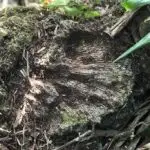
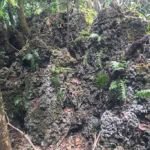
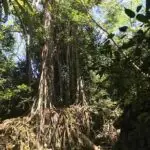
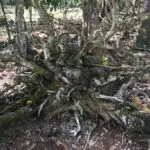
Table of Contents
Share This
What is a limestone forest?
A limestone forest is a unique ecosystem consisting of a limestone ground upon which plants and animals exist. Limestone soils are generally very shallow, with a pH of 7 to 8 (neutral to mildly alkaline). They’re also nutrient-poor, high in calcium carbonate (CaCO₃), and very well-drained. The unique physical and chemical properties of the soil influence the types of plants that can thrive in this habitat.
Other features of limestone forests are sinkholes and caves, which are home to animals such as crabs and swiftlets. A few species are endemic to this type of forest, and the forest is essential to their survival. On Guam, limestone forests occupy 33 percent of the land. They make up 70 percent (approximately 18,098 hectares) of the island’s forests, and are found primarily in the northern half of Guam.
How was Guam's limestone formed?
Volcanic eruptions beginning 56 million years ago formed the southern part of Guam. One volcano formed what would become the northern part of Guam. Once volcanic activity ceased, coral reefs grew in the shallow waters around the volcanic peaks. Gradually, the corals and other hard-bodied marine organisms deposited calcium carbonate skeletons, which accumulated, extending the coral reefs around the island. As these sea creatures died, their skeletons and shells accumulated; erosive processes including wave action and grinding activities of animals that eat corals, shells and algae. The organic matter, or tissue, found in the ingested plants and animals, is digested, while the limestone material from the skeletons and shells are excreted, forming sand. The sand was deposited as sediment, which was then compacted and cemented together to make limestone. Limestone rock has vertical cracks called joints and horizontal cracks (cemented layers) called bedding planes. Sometimes whole animals or shells get trapped within the bedding planes, creating a fossil record of organisms that existed during the period of formation (Figure 1).
Movement of the Marianas Plate resulted in the uplifting, or vertical elevation, of the reef. Each time the reef uplifted, the cycle of limestone formation began again in the shallow waters. This cycle of reef building and uplifting formed the northern plateau of Guam, as well as the high cliffs on the eastern coast. There are also deposits of old limestone formed after the early volcanic eruptions in the southern part of Guam, such as in Hågat and Sånta Rita-Sumai.
Karstification: Thousands of years in the making
Once the limestone is formed, it weathers. Rainwater and carbon dioxide from the air and soil mix to form a weak acid. As the slightly acidic water percolates through the joints and bedding planes, it dissolves the calcium carbonate in a process called karstification. The water continues carving its way to sea level, creating an aquifer of fresh water. The landscape produced by this process over thousands of years is called karst, which is characterized by fissures, caves, sink holes, rimstone pools, and jagged terrain. Figure 2 shows an example of karst terrain in the limestone forest. The karst features provide the habitat for endemic species living in limestone forests.
Different species in the limestone forests
Limestone forests provide habitat to some of the island’s native endangered species. Table 1 lists the common tree species found in the limestone forests. Native flora and fauna are well adapted to the limestone environment. Figure 3 shows Ficus prolixa, or nunu, a tall common native tree species adapted to the shallow limestone soil. The karst features provide homes for fruit bats, or fanihi (which are endangered animals on Guam) in caves, and coconut crabs, or ayuyu in the crevices. The larvae of the eight-spot butterfly (Hypolimnas octocula mariannensis), another endangered species, believed to only exist on Guam, feed exclusively on the herbaceous shrub species, Elatostema calcareum (an understory plant) and Procris pedunculata (an epiphyte). These two host plants are only found on karst substrates, limiting the butterfly’s range. Because of their adaptation to the limestone karst environment, many endemic species are not able to survive outside this ecosystem.
Table 1
Table 1. Common and endangered tree species found in limestone forests.
| Scientific name | CHamoru name | Status |
|---|---|---|
| Aglaia mariannensis | Mapuñao, Mapunyao | common native tree |
| Cocos nucifera | Niyok | common native tree |
| Cycas micronesica | Fadang | native tree (endangered) |
| Cynometra ramiflora | Gulos | common native tree |
| Elatostema calcareum | Tupun ayuyu | herbaceous shrub |
| Eugenia reinwardtiana | A’abang | common native tree |
| Ficus prolixa | Nunu | common native tree |
| Guamia mariannae | Paipai | common native tree |
| Intsia bijuga | Ifit | common native tree |
| Ochrosia mariannensis | Langiti | common native tree |
| Ochrosia oppositifolia | Fagot | common native tree |
| Pandanus tectorius | Kaffo’ | common native tree |
| Pisonia grandis | Umumu | common native tree |
| Premna serratifolia | Åhgao | common native tree |
| Procris pedunculata | N/A | herbaceous shrub |
| Serianthes nelsonii | Håyun lågu, Trongkon guåfi | endemic tree (endangered) |
Threats to Guam's limestone forests
Guam’s limestone forests face several challenges today. Because limestone soils are generally shallow, trees are not deeply rooted and are prone to knocked down by wind, mainly during storms and typhoons. Figure 4 shows an example of a fallen tree in the limestone forest. Another challenge – especially for the endemic and endangered species adapted to the limestone habitat – is human developments, which are diminishing habitats for native flora and fauna.
One example of human developments on limestone forest is the construction related to the US military buildup, specifically the relocation of the US Marines from Okinawa to Guam. In addition to building a base to house Marines and their families, the buildup includes a firing range on the Northwest Field of Andersen Air Force Base. Approximately 700 acres are allocated for the entire live-fire training range complex. Of those 700 acres, 315 are for the actual ranges. Of that 315, 89 acres lie in native limestone forest.
Invasive species such as pigs and deer (which are ungulates, or hoofed mammals) disrupt the soil by grazing heavily and trampling on new seedlings. This prevents new plants from growing.
According to botanist William E. Safford, ungulates were introduced to Guam by Spanish colonists in the 1700s. They were originally domesticated but, over time, became feral. Hunters help reduce feral ungulate populations, and methods such as using high-quality fencing in forest conservation plots keep ungulates from damaging priority areas of the forests. A good example of this can be seen around the mother tree of the endangered species håyan lågu (Serianthes nelsonii), which is the last adult tree of its kind on Guam. A high-quality fence surrounds the tree to prevent ungulate damage.
Another invasive species, the brown treesnake (Boiga irregularis), has severely harmed the seed dispersal of Guam forest species by decimating native bird populations. Accidentally introduced to Guam in the mid-1940s, the brown tree snake spread rapidly throughout the island because it had no natural predators. The brown treesnake is considered largely responsible for the extinction of 12 species of endemic birds, though other factors, such as habitat destruction, were also instrumental. Research on the brown treesnake on Guam has made the island one of the forerunners for invasive species research, but the snake remains on Guam, preventing bird species from recovering.
The effects of the brown treesnake are more severe than ungulate damage because of the importance of the role that birds play in tropical islands. Many tree species in the tropics rely on birds to spread their seeds. They eat fleshy or semi-fleshy fruit from trees and excrete undigested seeds onto the forest floor, usually away from a parent tree. Spreading seeds of a species away from where it is usually established may provide advantages for seeds to forest new areas, where there are generally fewer pathogens and predators, and less competition for light, water, and nutrients. All these threats leave our limestone forests in a very vulnerable state.
Managing the invasive, protecting the endangered
Because the forests are under threat, many people are working to help them.
Among the groups involved are:
- US Department of Defense
- US Fish and Wildlife Service
- US Department of Agriculture Animal and Plant Health Inspection Services (APHIS)
- University of Guam
- National Parks Service
- Local environmental firms
They work to manage and eradicate invasive species and to conserve and propagate endangered species with help from laws such as the US Endangered Species Act, which aims to protect and recover threatened or endangered species.
For example, the US Department of Agriculture APHIS Wildlife Services coordinates efforts to control and prevent the spread of the brown tree snake onto nearby islands. Among other methods, it does so by trapping snakes in high-risk areas and by inspecting cargo.
On the conservation side, projects such as forestry surveys by various local environmental firms and the Guam Plant Extinction Prevention Program focus on assessing and monitoring the health of Guam’s forests.
Ideally, if the brown tree snake can be controlled or eradicated, reintroducing native bird species to Guam could be one way to help improve the health of the limestone forests. Additionally, eradicating feral ungulates would reduce forest destruction and allow new plant growth to establish with less difficulty.
In the “Limestone Forest” volume of the Life On Guam school textbook series, published in 1976, author Larry Behrens posed two questions: How much of our natural environment should we give up in the name of progress and how much of our natural environment must we keep in order to maintain an acceptable standard of living?
These questions are still relevant today. We must continue to raise awareness of the threats to the limestone forests – from invasive species to the effects of human developments on the natural environment – to preserve the limestone ecosystems and the endemic and endangered species.
Places to visit on Guam to see karst features
About the authors

Raymond “Gerard” Chargualaf is a graduate student in the Sustainable Agriculture, Food, and Natural Resources (SAFNR) graduate program at the University of Guam. He works with the Guam Plant Extinction Prevention Program.
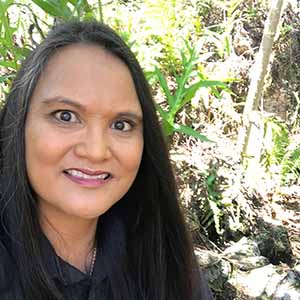
Monica Salas graduated with a BA in biology from the University of Guam in 1991 and was a graduate student in the MS biology program. She was a Criminalist at the Guam Police Department Crime Lab.
Editor’s note: These authors were beginning graduate students in 2019, taking a course in scientific writing at the University of Guam. This article was assigned to provide the students with practice in communicating science to non-scientists. The students chose the topic, which is related either to their thesis project or work experience. The instructor in the course is Dr. Laurie Raymundo, a UOG Marine Laboratory faculty member.
For further reading
Behrens, Lawrence. Life on Guam: Limestone Forest. Hagåtña: Guam Department of Education, 1976.
Morton, John M., Fred A. Amidon, and Lena R. Quinata. “Structure of a Limestone Forest on Northern Guam.” Micronesica 32, no. 2 (2000): 229-244.
Ossola, Alexandra. “Guam’s Ecological Fate is in the Hands of the US Military.” National Geographic, 27 December 2018.
Raulerson, Lynn, and Agnes F. Rinehart. Trees and Shrubs of the Mariana Islands. Saipan: Commonwealth of the Northern Mariana Islands Coastal Resources Management, 1991.
US Department of Agriculture Forest Service. Guam’s Forest Resources, 2002. By Joseph A. Donnegan, Sarah L. Butler, Walter Grabowiecki, Bruce A. Hiserote, and David Limtiaco. Resource Bulletin PNW-RB-243. Portland: PNW, 2004.
